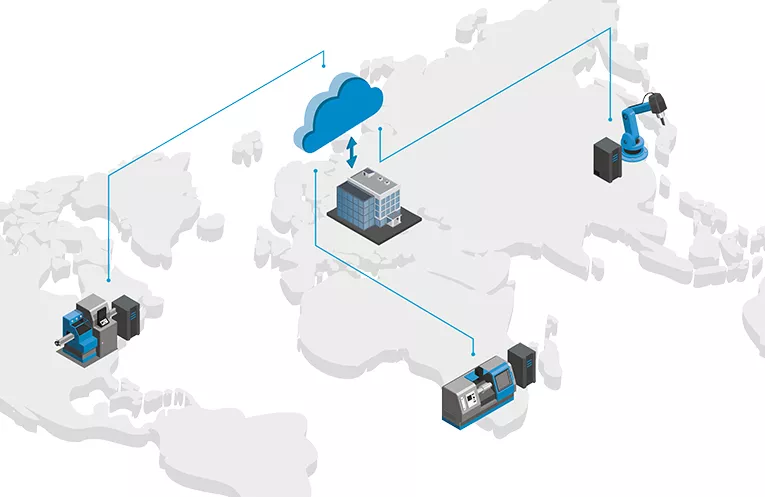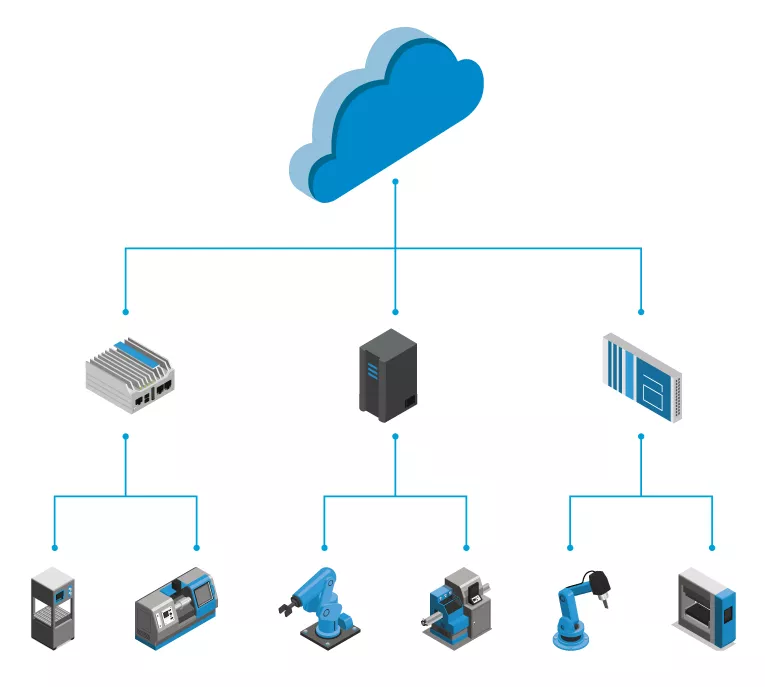Industrial Edge Computing
Introduction
Edge computing represents a major technological advance for industrial automation. It offers the benefit of data collection, processing, storage and analysis in real-time for more informed and faster decision making in complex production environments. This opens up a wide range of possibilities for manufacturers that were thought to be impossible when industrialization first began.
The first industrial revolution focused on mechanization, powering hitherto hand-made production and creating larger factories with higher performance. With the advent of computers and electronics, another revolution in manufacturing was started. The automation of processes became possible for the first time. In the past years, the industrial Internet of Things (IoT) began to once again revolutionize the world of manufacturing and production. The main question today is how to build a ‘smart factory’ - one that is that is highly autonomous and maximally efficient.
Bringing connectivity to industrial machines provides access to valuable data and enables software updates that contribute to significant improvements in productivity and efficiency on the shop floor. In order to leverage this wealth of data, that was previously unavailable and now becomes available to users, it needs to be collected, processed and analyzed. The resulting insights can then be used to develop new processes which improve machine performance. Therefore, the industrial Internet of Things vision is dependent upon technologies that are open, standard and interoperable – such as industrial edge computing.
What is cloud computing?
Industrial edge computing can be seen as an extension of cloud computing. Cloud computing services are set-up and managed either by the user or by an external service provider and hosted on servers connected to the Internet. This infrastructure enables companies to easily collect data from their equipment, be it from one single location or from all around the world. This data can be stored and analyzed, providing the basis for production planning or the innovation and optimization of processes. Cloud computing thus provides users with a comprehensive data pool that is easy to maintain, flexible and cost-efficient.
However, as more and more services are digitized and automated, the amount of data generated increases. Real-time requirements of applications, bandwidth and security issues also show the limits of cloud computing. Safety-critical decisions in automated driving (“Does the car have to brake immediately to avoid an accident?”) or industrial environments (“Does the machine need to stop now to prevent injury?”) demand immediate solutions. In such cases, sending data to the cloud for processing and decision-making is inefficient and, if delays in transmission occur due to low latency or bad connections, may have potentially fatal results.
This is where edge computing comes in.

What is edge computing?
Edge computing devices provide decentralized computational capacity on the shop floor where machine data is generated. In a smart factory’s edge computing architecture, cloud services are still available for consolidating large amounts of data. However, servers can be expensive to run and issues around latency and security can arise. Edge computing offers a local alternative where machine data is collected, stored and analyzed at the source. The data is therefore available in real-time and it is actionable, i.e. available for immediate use for operating the plant, optimizing processes, or preventing accidents. Edge devices are able to select the data needed for taking immediate actions. Once the operation has concluded, the edge device can discard data that is no longer needed or pass some or all of it on for storage and further analysis in the cloud.
By running analytics and other complex applications at the edge of the network, manufacturers can avoid the costs associated with high-capacity cloud servers and high-volume data transfer capabilities. Edge computing also minimizes network latency, allowing critical control applications to become more connected. The flexibility to decide where to execute tasks improves machine performance, and results in more efficient production. Further efficiency improvements can be made by implementing smart services, that rely on the data from connected devices.
Depending on the application, edge computing may also increase data security. Firstly, less sensitive data (e.g. production-critical data) is transferred from the factory to the cloud, decreasing the risk of cyberattacks in transit. Secondly, there is no single point of entry into the system. Thus, even if one device is compromised, the system itself will remain stable. However, in some instances, having a larger number of edge devices connected to the network increases risk, particularly as not all devices have the same level of security.
Sometimes, the term fog computing is used in the context of edge computing. Both terms indicate computing that is close to the shop floor, and they are more or less interchangeable. Fog computing is often associated as a local network in which all devices participate and share resources. Edge computing devices on the other hand can be used flexibly, either as individual nodes directly connecting a machine to the cloud, or as part of a wider ‘fog-like’ network.

What are the main benefits of edge computing in industrial applications?
With edge computing, it is possible to gain in-depth insights into the running and performance of machines. This allows fast response in the event of anomalies as well as planning of improvements and predictive maintenance to ensure that production is not impacted by downtimes.
In addition, not all machine data needs to be sent to the cloud, decreasing storage cost and bandwidth requirements. As data from the edge is available in real-time, it can be shared with customers or engineers on-premise as needed, e.g. when servicing a machine.
Another advantage of edge computing is that it allows machine builders to offer new services, such as remote software updates.
Edge computing at a glance:
- Foundation for smart, digital connectivity of machines
- Collection, storage and analysis of machine data at the source
- Convergence of multiple functions on one device
- Remote management of software and devices
- Implementation of new smart services
Applications of edge computing
When it comes to real-time, actionable data, edge computing is the technology of choice. It is essential to automated driving applications and offers decided advantages for security systems, health-monitoring and wearable devices. In the industrial sector, edge computing helps to improve productivity, worker safety and save operational cost.
To leverage the potential of edge computing, TTTech Industrial created Nerve, an industrial edge computing platform delivering flexibility and openness. Nerve products provide a software infrastructure for the plant floor and the cloud that enables users to access data, manage devices and deploy applications remotely. Below are some examples of how TTTech Industrial’s customers use the Nerve product line in their production.
Felss, a machine builder, specializing in cold forming of metal pipes and materials for automotive manufacturing uses Nerve to:
- Secure data connectivity on the machine, in the factory and to the cloud
- Develop and deploy “smart services”
- Easily install new applications and software updates
Find out more in the case study.
Fill, a leading international machine and plant engineering company uses Nerve to:
- Quickly and easily transfer real-time data from machines to their predictive maintenance solution
- Run analytics application at the edge of the network
- Offer new IIoT services to customers for new and already installed machines
Find out more in the case study.
Want to know more?
In our whitepaper section, we address a number of use cases of our edge computing platform Nerve across industries: from food processing, to the process industry and the energy sector. We also look at more technical aspects such as the real-time virtualization of control and the benefits of workload consolidation.

Find out more about Nerve by clicking on the link below or contact us at sales@tttech-industrial.com for further information.